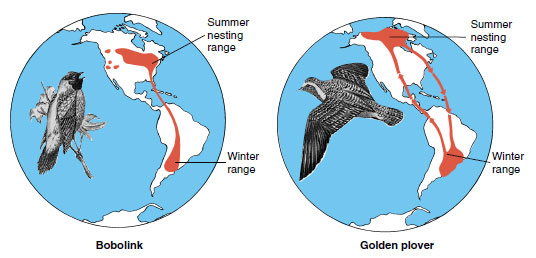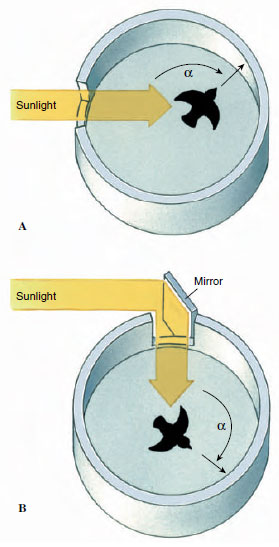Migration and Navigation
Migration and
Navigation
We described advantages of migration in the prologue to this section. Not all birds migrate, of course, but the majority of North American and European species do, and the biannual journeys of some are truly extraordinary undertakings.
Migration Routes
Most migratory birds have well-established routes trending north and south. Since most birds (and other animals) live in the Northern Hemisphere, where most of the earth’s landmass is concentrated, most birds migrate south in winter and north in summer. Of the 4000 or more species of migrant birds (a little less than half the total bird species), most breed in the more northern latitudes of the hemisphere; the percentage of migrants in Canada is far higher than the percentage of migrants in Mexico, for example. Some use different routes in the fall and spring (Figure 29-20). Some, especially certain aquatic species, complete their migratory routes in a very short time. Others, however, make a leisurely trip, often stopping along the way to feed. Some of the warblers are known to take 50 to 60 days to migrate from their winter quarters in Central America to their summer breeding areas in Canada. Many of the smaller species migrate at night and feed by day; others migrate chiefly in the daytime; and many swimming and wading birds migrate by either day or night.
Many birds are known to follow landmarks, such as rivers and coastlines, but others do not hesitate to fly directly over large bodies of water in their routes. Some birds have very wide migration lanes, whereas others, such as certain sandpipers, are restricted to very narrow ones, keeping well to the coastlines because of their food requirements.
Some species are known for their long-distance migrations. The Arctic tern, greatest globe spanner of all, breeds north of the Arctic Circle during the northern summer, then migrates to the Antarctic regions for the northern winter. This species also is known to take a circuitous route in migrations from North America, passing over to the coastlines of Europe and Africa and then to their winter quarters, a trip that may exceed 18,000 km (11,200 miles). Other birds that breed in Alaska follow a more direct line down the Pacific coast of North and South America.
Many small songbirds also make great migratory treks (Figure 29-20). Africa is a favorite wintering ground for European birds, and many fly there from Central Asia as well.
Stimulus for Migration
Humans have known for centuries that the onset of the reproductive cycle of birds is closely related to season. Only within the last 60 years, however, has it been proved that the long days of late winter and early spring stimulate the development of the gonads and accumulation of fat—both important internal changes that predispose birds to migrate northward. Long day length stimulates the anterior lobe of the pituitary into activity. The release of pituitary gonadotropic hormone in turn sets in motion a complex series of physiological and behavioral changes, resulting in gonadal growth, fat deposition, migration, courtship and mating behavior, and care of the young.
Direction Finding in Migration
Numerous experiments suggest that most birds navigate chiefly by sight. Birds recognize topographical landmarks and follow familiar migratory routes—a behavior assisted by flock migration, during which navigational resources and experience of older birds can be pooled. But in addition to visual navigation, birds make use of a variety of orientation cues at their disposal. Birds have a highly accurate innate sense of time. They also have an innate sense of direction; and recent work adds credence to an old, much debated hypothesis that birds can detect and navigate by the earth’s magnetic field. All of these resources are inborn and instinctive, although a bird’s navigational abilities may improve with experience.
Experiments by German ornithologists G. Kramer and E. Sauer and American ornithologist S. Emlen demonstrated convincingly that birds can navigate by celestial cues: the sun by day and the stars by night. Using special circular cages, Kramer concluded that birds maintain compass direction by referring to the sun, (Figure 29-21). This is called sun-azimuth orientation (azimuth, compass bearing of the sun). To use the sun as a compass birds must know the time of day because the sun’s position changes throughout the day. By exposing birds to altered light cycles to shift their perception of daybreak, researchers showed that birds do use an internal clock in this fashion. Sauer’s and Emlen’s ingenious planetarium experiments strongly suggest that some birds, probably many, are able to detect and navigate by the North Star axis around which the constellations appear to rotate.
Some of the remarkable feats of bird navigation still defy rational explanation. Most birds undoubtedly use a combination of environmental and innate cues to migrate. Migration is a rigorous undertaking. The target is often small, and natural selection relentlessly prunes off individuals making errors in migration, leaving only the best navigators to propagate the species.
We described advantages of migration in the prologue to this section. Not all birds migrate, of course, but the majority of North American and European species do, and the biannual journeys of some are truly extraordinary undertakings.
Migration Routes
Most migratory birds have well-established routes trending north and south. Since most birds (and other animals) live in the Northern Hemisphere, where most of the earth’s landmass is concentrated, most birds migrate south in winter and north in summer. Of the 4000 or more species of migrant birds (a little less than half the total bird species), most breed in the more northern latitudes of the hemisphere; the percentage of migrants in Canada is far higher than the percentage of migrants in Mexico, for example. Some use different routes in the fall and spring (Figure 29-20). Some, especially certain aquatic species, complete their migratory routes in a very short time. Others, however, make a leisurely trip, often stopping along the way to feed. Some of the warblers are known to take 50 to 60 days to migrate from their winter quarters in Central America to their summer breeding areas in Canada. Many of the smaller species migrate at night and feed by day; others migrate chiefly in the daytime; and many swimming and wading birds migrate by either day or night.
Many birds are known to follow landmarks, such as rivers and coastlines, but others do not hesitate to fly directly over large bodies of water in their routes. Some birds have very wide migration lanes, whereas others, such as certain sandpipers, are restricted to very narrow ones, keeping well to the coastlines because of their food requirements.
Some species are known for their long-distance migrations. The Arctic tern, greatest globe spanner of all, breeds north of the Arctic Circle during the northern summer, then migrates to the Antarctic regions for the northern winter. This species also is known to take a circuitous route in migrations from North America, passing over to the coastlines of Europe and Africa and then to their winter quarters, a trip that may exceed 18,000 km (11,200 miles). Other birds that breed in Alaska follow a more direct line down the Pacific coast of North and South America.
Many small songbirds also make great migratory treks (Figure 29-20). Africa is a favorite wintering ground for European birds, and many fly there from Central Asia as well.
 |
| Figure 29-20 Migrations of the bobolink and golden plover. The bobolink commutes 22,500 km (14,000 miles) each year between nesting sites in North America and its wintering range in Argentina, a phenomenal feat for such a small bird. Although the breeding range has extended to colonies in western areas, these birds take no shortcuts but adhere to the ancestral seaboard route. The golden plover flies a loop migration, striking out across the Atlantic in its southward autumnal migration but returning in the spring by way of Central America and the Mississippi Valley because ecological conditions are more favorable at that time. |
 |
| Figure 29-21 Gustav Kramer’s experiments with sun- compass navigation in starlings. A, In a windowed, circular cage, the bird fluttered to align itself in the direction it would normally follow if it were free. B, When the true angle of the sun is deflected with a mirror, the bird maintains the same relative position to the sun. This shows that these birds use the sun as a compass. The bird navigates correctly throughout the day, changing its orientation to the sun as the sun moves across the sky. |
Stimulus for Migration
Humans have known for centuries that the onset of the reproductive cycle of birds is closely related to season. Only within the last 60 years, however, has it been proved that the long days of late winter and early spring stimulate the development of the gonads and accumulation of fat—both important internal changes that predispose birds to migrate northward. Long day length stimulates the anterior lobe of the pituitary into activity. The release of pituitary gonadotropic hormone in turn sets in motion a complex series of physiological and behavioral changes, resulting in gonadal growth, fat deposition, migration, courtship and mating behavior, and care of the young.
Direction Finding in Migration
Numerous experiments suggest that most birds navigate chiefly by sight. Birds recognize topographical landmarks and follow familiar migratory routes—a behavior assisted by flock migration, during which navigational resources and experience of older birds can be pooled. But in addition to visual navigation, birds make use of a variety of orientation cues at their disposal. Birds have a highly accurate innate sense of time. They also have an innate sense of direction; and recent work adds credence to an old, much debated hypothesis that birds can detect and navigate by the earth’s magnetic field. All of these resources are inborn and instinctive, although a bird’s navigational abilities may improve with experience.
Experiments by German ornithologists G. Kramer and E. Sauer and American ornithologist S. Emlen demonstrated convincingly that birds can navigate by celestial cues: the sun by day and the stars by night. Using special circular cages, Kramer concluded that birds maintain compass direction by referring to the sun, (Figure 29-21). This is called sun-azimuth orientation (azimuth, compass bearing of the sun). To use the sun as a compass birds must know the time of day because the sun’s position changes throughout the day. By exposing birds to altered light cycles to shift their perception of daybreak, researchers showed that birds do use an internal clock in this fashion. Sauer’s and Emlen’s ingenious planetarium experiments strongly suggest that some birds, probably many, are able to detect and navigate by the North Star axis around which the constellations appear to rotate.
Some of the remarkable feats of bird navigation still defy rational explanation. Most birds undoubtedly use a combination of environmental and innate cues to migrate. Migration is a rigorous undertaking. The target is often small, and natural selection relentlessly prunes off individuals making errors in migration, leaving only the best navigators to propagate the species.




